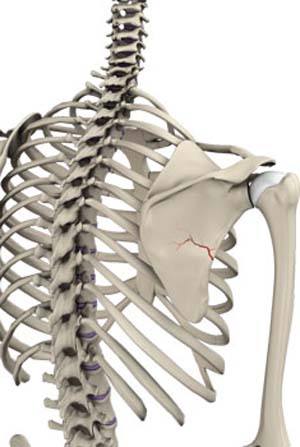
What is Fracture of the Shoulder Blade (Scapula)?
The scapula (shoulder blade) is a flat, triangular bone providing attachment to the muscles of the back, neck, chest and arm. The scapula has a body, neck and spine portion.
Scapular fractures are uncommon but do occur and require a large amount of force to fracture. They are usually the result of intense trauma, such as a high-speed motor vehicle accident or a fall from a height onto one’s back. They can also occur from a fall on an outstretched arm if the humeral head impacts on the glenoid cavity.
What are the Symptoms of Scapula Fractures?
Symptoms of a scapular fracture include the following:
- Pain: Usually severe and immediate following injury to the scapula.
- Swelling: The scapular area quickly swells following the injury.
- Bruising: Bruising occurs soon after injury.
- Impaired Mobility: Decreased range of motion of the joint occurs, often with the inability to straighten the arm.
- Numbness: Numbness, tingling, or coldness of the hand and forearm can occur if blood supply is impaired or nerves are injured.
- Popping Sound: A cracking or popping sound, also referred to as crepitus, can often be heard or felt at the time of the fracture.
How is a Scapular Fracture Diagnosed?
Scapular fractures should be evaluated by an orthopedic surgeon for proper diagnosis and treatment. Your surgeon will review your medical history and perform a physical examination. Diagnostic studies may include:
- X-rays: A form of electromagnetic radiation that is used to take pictures of bones.
- CT scan: This test creates images from multiple X-rays and shows your physician structures not seen on a regular X-ray.
- MRI: Magnetic and radio waves are used to create a computer image of soft tissue such as nerves and ligaments.
What are the Treatment Options?
Most scapular fractures are not significantly displaced due to the strong supporting soft tissue structures surrounding it. Therefore, a majority of scapular fractures are treated conservatively and with early motion to reduce the risk of stiffness and will usually heal without affecting shoulder movement. Conservative treatment options include:
- Immobilization: A sling is used for comfort and to support the shoulder to allow healing to take place. This is usually worn about 3-6 weeks depending on the type of fracture and how well you heal.
- Prescription Medications: Pain medications will be prescribed for your comfort during the healing process.
- Physical Therapy: Early progressive range of motion exercises is essential in restoring full shoulder function. Your physician will most likely refer you to a Physical Therapist for instruction on proper exercises and early motion of the shoulder to prevent complications.
Surgical Introduction
Fractures of the scapula involving the neck or glenoid or with severe displacement have been associated with poor outcomes when treated non-operatively. and would usually require surgical intervention to realign the bones properly and restore a functional, pain-free range of motion to the shoulder joint. Scapular fracture repair surgery has historically been performed through a large, open incision. Newer, minimally invasive techniques have evolved and surgery to repair scapular fractures can now be performed through arthroscopy.







